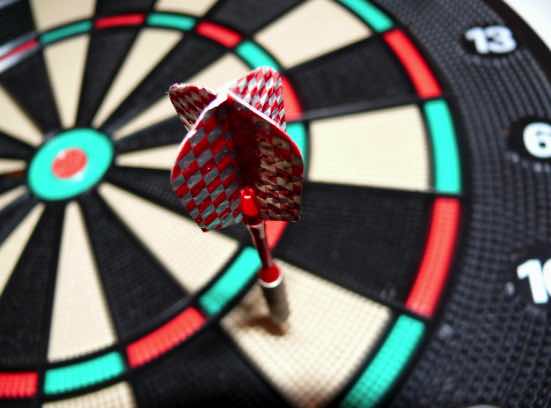This post may contain affiliate links — Please read our affiliate disclosure.
Last updated on October 1, 2021
Scoring darts is something not a lot of players want to do, but it’s an ideal way to really learn the mechanics of scoring and the mental arithmetic that’s required to become a truly competent dart player. Think of it as a shortcut to mastering darts rules.
The scoreboard
Today, whiteboards may be used instead of chalkboards, though the latter is still very common, because it’s considered the “classic” scoreboard, and a lot of old bars still have their original scoreboard, which would obviously have been chalk.
Either way, the scoreboard will basically look the same. You’ll have two main columns: one for one team, one for another. One team may be marked “home” and the other “away”, though this isn’t always the case. The board is divided down the middle with numbers, starting with 20 at the top and bullseye at the bottom.
Typically, there will be an “’01” with a blank space to the left. The blank space is so that you can write which type of ’01 game you’re playing. If you’re playing 501, you’d put a 5, and likewise for 301—pretty basic stuff. But it also helps you easily keep track when it comes type to actually score a game of 501 or 301 (or 1001, if that’s more your thing).
Scoring a dart game
For the purposes of this article, we’re going to assume we’re playing 501 to simplify things. On each player’s (or team’s) side of the scoreboard, there will be two columns. The column on the left is for how many points you scored in your first turn. The column on the right is where you subtract that score from your starting total (501). So, if you threw 30, you’d put a thirty on the left side and subtract 30 from 501, getting 471, which you’d write on the right side of your column.
To put it in the simplest terms: the left side of your side of the scoreboard is for what score you got in that particular turn; the right side is for the subtracting that score from the previous total and logging it as the new total points until the next turn is thrown.
If it sounds like you’re doing math, you are. But this is important, because great darts players are always thinking on their feet. In 501, you have to throw a double on your last turn, reaching zero, to win. This requires some thought on your part because it’s a very specific number that you’re going to have to throw. Scoring is a great way to get comfortable with the mathematics behind darts and, in turn, makes you a much more efficient dart player yourself.

